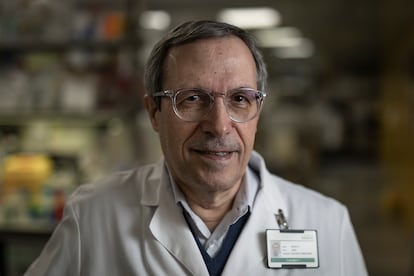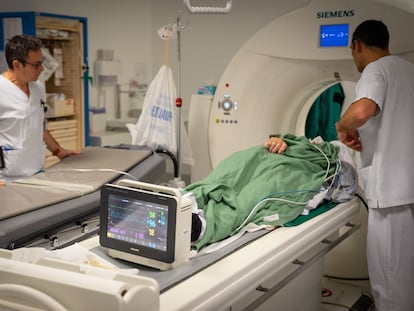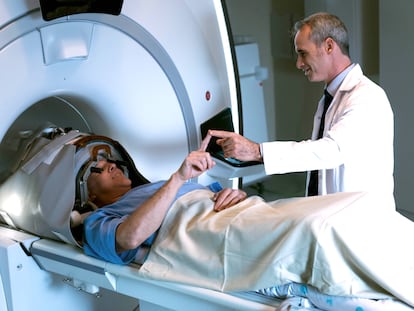Neurologist Josep Dalmau: ‘We are discovering amazing things, the brain never stops surprising us’
The researcher, who revolutionized the discipline by describing new types of autoimmune encephalitis, is researching the consequences that these processes leave in the body


One day at the age of 24, Susannah Cahalan discovered that the world had become a “brighter, louder, and more painful” place. It was just the beginning of several delirious weeks in which everything changed for the journalist with The New York Post. Sometimes she saw insects that were biting her. The left side of her body was numb. She couldn’t sleep despite being exhausted. And her behavior became erratic.
The night she suffered a major crisis at her boyfriend’s house marked the beginning of a long and erroneous list of diagnoses: alcohol withdrawal syndrome, bipolar disorder, even schizophrenia. Brain on Fire is the eloquent title of the book, later turned into a film, in which Susannah narrates the devastation caused by a disease as rare as it is terrifying. Autoimmune encephalitis is the result of an attack by the immune system on the neurons in the brain. The estimated incidence of the disease is one case per year per 100,000 people.
Cahalan suffered her episode in 2009 and medicine was able to find a diagnosis thanks to the fact that, only two years earlier, Josep Dalmau, a neurologist who then worked at the Hospital of the University of Pennsylvania, had discovered the mechanisms behind a type of swelling of the brain called “anti-NMDAR encephalitis.” Its name refers to the patient’s antibodies attacking the NMDA receptor.
A look at the walls of Dalmau’s current office at the Idibaps-Hospital Clínic in Barcelona (Spain) gives an idea of the global impact that the breakthrough had. It was a milestone that would lead the scientist and his team of researchers to describe 12 of the 16 forms of autoimmune encephalitis that have been described since then. There are three discreetly framed covers of The Lancet Neurology that featured Dalmau’s work. And there is also the invitation he received from the United States National Academy of Medicine to be part of the institution, that he admits made him especially excited. Only two other researchers who practice in Spain, the pharmacologist María José Alonso and the pathologist Elías Campo, share this distinction.
Question. Why did it take so long for medicine to understand autoimmune encephalitis?
Answer. They are actually a large group of complex diseases. We knew very little about them 20 years ago and today we understand them better. But there are still some whose cause is not well understood.
Q. Why does the immune system attack the brain?
A. In some cases, the reason is the presence of tumor proteins that are similar or identical to brain proteins. These proteins trigger an immune response in which antibodies also attack those in the brain. The tumor may be benign and so small that it has not been detected by medical professionals, but the process it sets in motion can be devastating. There are also other factors that we are learning about, such as a certain genetic predisposition or some oncological treatments.
Q. How does the patient experience the disease?
A. Any of the brain’s functions may be affected. Sometimes the outward signs are similar to psychiatric disorders, others cause motor, sensory, sleep alterations, or epileptic seizures. What is notable is that each autoimmune encephalitis has a different symptom profile. And they are very serious processes, which often require long admissions to the ICU and some are associated with high mortality if they are not treated.
Q. Which people do these types of encephalitis affect the most?
A. It depends on the type. Some affect young women and children more, others affect people over 50 or 60 years old.
Q. Your discovery is often cited as a paradigm shift. Why?
A. It was the key that opened the door to new knowledge about many forms of autoimmune encephalitis. Twenty years ago, only one group was known. They were related to cancer and usually affected people over 50 years of age. But we saw that there were others that were equally serious, but that the patients could be much younger and included adolescents and children. Sometimes they did not have a tumor or, if they did, it was benign. All of this had a great impact on neurology, pediatrics, psychiatry, and intensive care, which were the branches of medicine that were dealing with these cases without really knowing how.

Q. How did you do it?
A. It was not a new method. You start with clinical observation. You see the symptoms and, almost automatically, you begin to mentally exclude illnesses. In the end you are left without knowing exactly what is happening. In this case it was a young woman of about 22 years old who had been in the ICU for almost two months. And then, and experience helps here, you remember that you have seen three other almost identical scenarios before. All young women with a small benign tumor and the same clinical profile...
Q. And what did you say to yourself at that moment?
A. Well, there is something you are missing. And this is when the research process begins. We took the matter to the laboratory because I was convinced that the process was immune-mediated, but all the initial antibody studies had been negative. So we had to make a series of technical variations. In the end we discovered that all four patients had antibodies in their cerebrospinal fluid that reacted exactly the same in the brain.
Q. And then what?
A. You return to the patient. Once the antibody is discovered, you look at what proteins it went against. This allows you to develop a very simple diagnostic test. And for the next patient, you already know how to diagnose them quickly and treat them, which is the goal.
Q. What was the treatment that you used?
A. If you know that it is an antibody-mediated encephalitis, the strategy is useful. It has to be refined for each type of encephalitis, but the basic treatment is to eradicate the antibodies. This can be done with techniques such as plasma exchange, which, in a way, washes the antibodies out of the blood. If this is not enough, you go to the base and get rid of the cells that produce the antibodies. This is done with certain monoclonal antibody treatments. And there are other more aggressive therapies. You escalate according to the severity and response to treatment. Most kinds of encephalitis respond to this strategy.
Q. Have you managed to relate each type of encephalitis to a specific cause?
A. If it is for reasons not related to a tumor, it is less relevant to do so. But if it is a tumor, yes, because the process can be repeated as long as the tumor remains and the immune system has been activated. This is why it is essential to look for the tumor and remove it.
Q. But it shouldn't be very difficult to find it, right?
A. Sometimes it is, because it may be very small. We see this from queries we receive from other places in the world where perhaps diagnostic means are limited. They might have patients who have been correctly diagnosed and have improved with the relevant treatment. But they relapse. And we tell them to look for the tumor. Or to take a good look at certain organs. And, a lot of the time, it turns out that it was there.
Q. Can you tell where the tumor is by the type of encephalitis?
A. A lot of the time, yes. Some encephalitis is associated with tumors in certain areas. Depending on the type of encephalitis and associated antibodies, we can say that physicians should search primarily in the abdominal area, the ovaries, or the lungs.
Q. How many types of encephalitis have been defined?
A. Since 2007, there have been 16 of this type, which is mediated by antibodies [those not related to types of cancer that affect older people]. But there are more that we have not managed to describe yet. Almost every year we see about 50 patients with types of encephalitis that we can assume are related to an antibody that has not yet been distinguished. Characterizing them is difficult because each one is practically a project in itself. They are like isolated cases that would be ideal to relate to others.
Q. What else is left to do?
A. Our most recent studies are trying to understand why there are patients who take many months to recover, and in other cases some alterations have become chronic. These cases continue to come to us from all over the world.
Q. And what do you do?
A. We have returned to the clinic to better define these patients’ long-term condition. We are characterizing the diseases in the chronic phase. There is a very long recovery phase that we still don’t fully understand. If the patient had antibodies and you eradicate them, why do they still have symptoms? We have rather interesting studies in this area, which no one has done until now, and which we are carrying out with the help of the Caixa Foundation.
We invite patients to come to Barcelona once they leave the hospital and have overcome the worst of the acute phase, but are still not well. We do a thorough examination. They are admitted overnight and we do a sleep record and other studies such as an encephalogram and brain MRI. We do this three times a year and we’re seeing what happens.
Q. Is that not a bit slow?
A. Yes, we continue through Zoom and other applications from the patients’ homes. We perform neuropsychological tests on them and, sometimes, we send them a type of headband that they can wear comfortably in bed and that performs an electroencephalographic recording while they sleep, and the data it collects is sent us via the internet.
Q. And what are you finding out?
A. Amazing things, the brain never stops surprising us. We have found that during the day, if you see the patient, they may appear fine. The surprise is that, thanks to these records, we have seen that many suffer very significant changes in their sleep structure during the night. They suffer epileptic seizures that we thought they had overcome and that probably contribute to cognitive and memory irregularities.
Q. And what can you do for them?
A. This is another area in which there is still a lot of progress to be made. Some patients improve by restarting or extending treatment. We are also studying how we can shorten the recovery period through remote cognitive rehabilitation.
Sign up for our weekly newsletter to get more English-language news coverage from EL PAÍS USA Edition
Tu suscripción se está usando en otro dispositivo
¿Quieres añadir otro usuario a tu suscripción?
Si continúas leyendo en este dispositivo, no se podrá leer en el otro.
FlechaTu suscripción se está usando en otro dispositivo y solo puedes acceder a EL PAÍS desde un dispositivo a la vez.
Si quieres compartir tu cuenta, cambia tu suscripción a la modalidad Premium, así podrás añadir otro usuario. Cada uno accederá con su propia cuenta de email, lo que os permitirá personalizar vuestra experiencia en EL PAÍS.
En el caso de no saber quién está usando tu cuenta, te recomendamos cambiar tu contraseña aquí.
Si decides continuar compartiendo tu cuenta, este mensaje se mostrará en tu dispositivo y en el de la otra persona que está usando tu cuenta de forma indefinida, afectando a tu experiencia de lectura. Puedes consultar aquí los términos y condiciones de la suscripción digital.









































